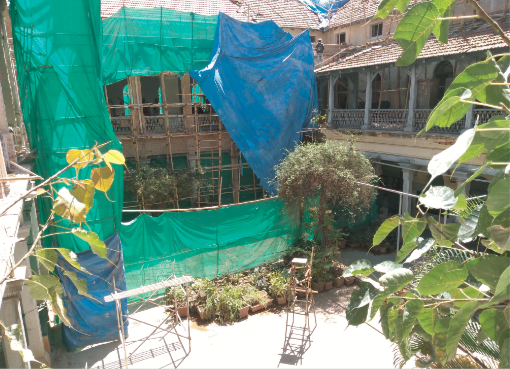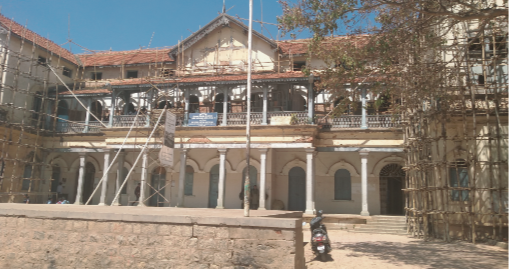Last year, a century old house in Malleshwaram, Bangalore, was brought down. The grand 19th century bungalow known as Villa Pottipatti was run by Neemrana Group of Hotels as a heritage hotel. However, the bungalow was recently razed down when it went into the hands of private developers. No heritage laws or bodies to stop it. A little before that the city had lost another century old building – a classical colonial structure known as Krumbiegel Hall. Krumbiegel, a botanist from Germany contributed to the horticultural landscape of Bangalore, Mysore and a host of other cities in the country. Once again no value for historic sites in the city.
Giving up on heritage
While some heritage structures fall prey to the rapid urban development, in some cases the owners themselves have no choice. ‘There is a dearth of skilled masons for repairing old buildings. In some cases I have to end up paying double to get a mason. It is better to sell my hundred-year-old property rather than retain it,’ mentioned a frustrated bungalow owner in the city.
There are other factors too that destroy heritage buildings. Environmental factors like moisture, sunlight, air pollution, temperature variations play a role too. Timber, bricks used in buildings can be affected by insects, moss etc. Moisture in timber and bricks can lead to cracks in walls. Sunlight can also dry out and damage surfaces leading to cracks and discoloration. Traffic vibrations enter the foundations of buildings and cause damage. Thus a dilapidated building is cause of concern, and often gets pulled down by authorities. Unlike Singapore that has a National Heritage Board to look after sites of historic value and give permission to the owner if any renovations have to be done or a structure has to be pulled down, in our country the legal laws for heritage monuments are very lax.
Fort High School- a heritage building

So it came as a nice surprise when the Bangalore Charter of Indian National Trust for Art and Cultural Heritage(INTACH) threw open Fort High School of Bangalore to the public to check out the conservation efforts going on in this 112-year-old building. Built in 1907, it was one of the first government High Schools in the princely State of Mysore. It started out as a boys’ school and offered up to eight languages – Arabic,Persian,Sanskrit, Telegu,Kannada to name a few. Earlier there was a school in the same premises that was managed by the Fort Church. The school was once single storied; today it is more than that. Occupying a three acre premises, having more than one floor with classrooms added it has been thrown open to girls as well. The school has seen stalwarts like Kengal Hanumanthaiah – former chief minister of the State, H.S. Doreswamy–freedom fighter, cricketer G.R. Vishwanath, film actor Shakti Prasad, etc., as its students. For a short while, Mysore Maharaja Jayachamarajendra Wodeyar too was a ward here.
The school along with a host of other buildings like Victoria Hospital, Summer Palace, armoury form part of the old fort area. Apart from this, cannons and stone balls were found during construction and excavation activities here making this an important historic site.
A couple of years ago this lime mortar building was not in a great condition. The walls were damp due to leakage, the clay roof tiles were damaged, and the floor, teakwood staircase were in a poor condition. The classrooms were pretty much useless, and the walls were badly in need of plaster. When INTACH did a survey it estimated the repair cost would come to about Rs. 2.5 crore. Ten months ago it started the restoration work. The focus was to repair roof tiles, floor, plaster the school walls with lime and mortar, repairing stairs and waterproofing of the building. And to see this first-hand an open day was organised by INTACH.
The school architecture
The colonial building is quite attractive. It has a mix of vernacular features like Madras terraces, teak wood staircase, central courtyard, etc. However it also has European features like Jack arches, Roman arches on windows and doors, Polonceau truss on ceilings , gables, cornices etc. While on the outside it looks quite English, inside it has the feel of a typical Indian classroom with a central courtyard and classrooms all around it. Sloping roofs with clay tiles, Madras terraces, teakwood staircase are all Indian elements added to the school. The building was built in two phases. The front portion was probably built in 1907, and later an extension was added to it. This can easily be made out. The first phase has the traditional Madras terraces, while the second phase added later has Jack arches and reinforced brick ceilings.
Interesting features of the school
There were some interesting architectural elements in the school. One of them was the Polonceau Truss with its eight ridges used in the roof design. It has timber, cast iron elements used in it and gives the rooms an impressive look. For the uninitiated, the truss is a roof design of the 19th century. It is basically a structure that has triangular units all arranged according to a predefined pattern. The Polonceau Truss was invented in 1839 by an engineer Camille Polonceau. The truss started out with timber-iron, later on it adopted pure iron constructions as well.
Another interesting feature is that of the gables in the building. The gables have the Dhajji Diwari system, also known as the brick nogged construction. Such types of construction are most often found in Kashmir. The timber framework makes it earthquake resistant. Generally in buildings the elevation of upper floors is less compared to the lower floors. But in the Fort High school the upper floor has a higher elevation thanks to its gables. The timber frame of the gables filled with brick masonry resists lateral deformations successfully. It also reduces the stress on the cornices — the ornamental features present in the front portion of the school building.
Conservation activities at school
Quite a lot of restoration work was carried out by the team involved in conservation of the building. The planks of Madras terrace were being replaced-not all, only the broken ones. The clay tiles on the sloping roofs were new. Some arches were being reconstructed; there was still work to be done to treat wooden and steel members on roof.
Use of traditional lime mortar
Lime mortar was getting used for wall plastering. ‘The beauty of lime is it allows the structure to breathe, is durable and is also less susceptible to cracks’, explained the team involved in restoration. The process of making the mortar is a long one. The quarried limestone is burnt in a kiln. The burnt limestone is made into putty by soaking it in water. The slaked lime is then mixed with sand, Surkhi and organic additives like jaggery, bael fruit or wood apple pulp to produce mortars and plasters. It is then applied on walls and checked to see if its consistency is right, then several layers are applied on walls. For restoration the same materials were being used when the school was first constructed.
In midst of all these activities classes were going on; the teachers didn’t complain, and lessons were carried on as usual. There was hope perhaps that with the school restored the strength would increase, and the school will run for another hundred years to come.


 [/column]
[/column]